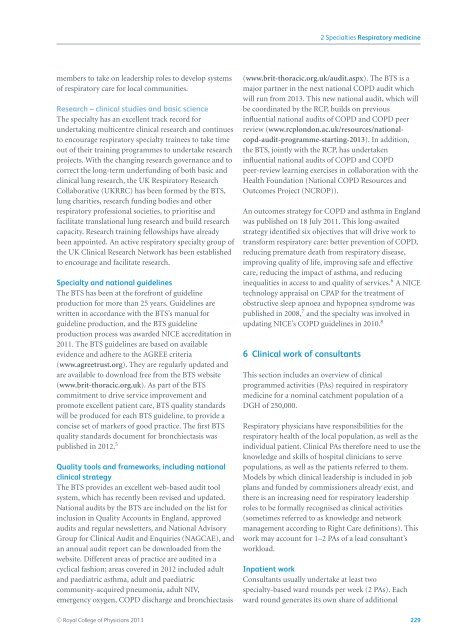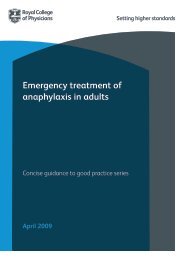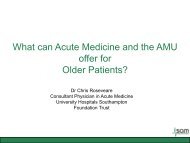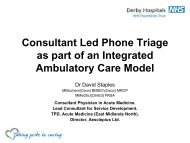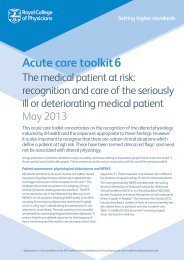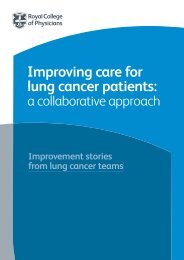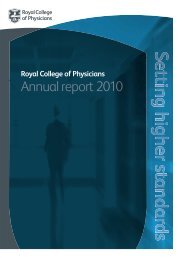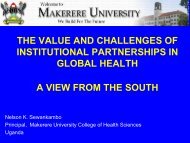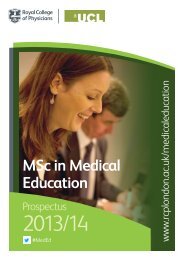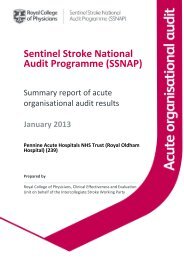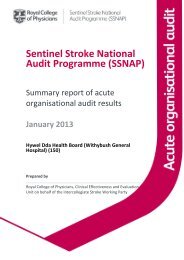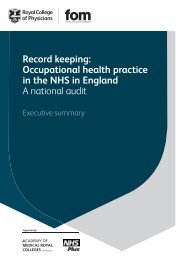Consultant physicians working with patients - Royal College of ...
Consultant physicians working with patients - Royal College of ...
Consultant physicians working with patients - Royal College of ...
You also want an ePaper? Increase the reach of your titles
YUMPU automatically turns print PDFs into web optimized ePapers that Google loves.
2 Specialties Respiratory medicinemembers to take on leadership roles to develop systems<strong>of</strong> respiratory care for local communities.Research – clinical studies and basic scienceThe specialty has an excellent track record forundertaking multicentre clinical research and continuesto encourage respiratory specialty trainees to take timeout <strong>of</strong> their training programmes to undertake researchprojects. With the changing research governance and tocorrect the long-term underfunding <strong>of</strong> both basic andclinical lung research, the UK Respiratory ResearchCollaborative (UKRRC) has been formed by the BTS,lung charities, research funding bodies and otherrespiratory pr<strong>of</strong>essional societies, to prioritise andfacilitate translational lung research and build researchcapacity. Research training fellowships have alreadybeen appointed. An active respiratory specialty group <strong>of</strong>the UK Clinical Research Network has been establishedto encourage and facilitate research.Specialty and national guidelinesThe BTS has been at the forefront <strong>of</strong> guidelineproduction for more than 25 years. Guidelines arewritten in accordance <strong>with</strong> the BTS’s manual forguideline production, and the BTS guidelineproduction process was awarded NICE accreditation in2011. The BTS guidelines are based on availableevidence and adhere to the AGREE criteria(www.agreetrust.org). They are regularly updated andare available to download free from the BTS website(www.brit-thoracic.org.uk). As part <strong>of</strong> the BTScommitment to drive service improvement andpromote excellent patient care, BTS quality standardswill be produced for each BTS guideline, to provide aconcise set <strong>of</strong> markers <strong>of</strong> good practice. The first BTSquality standards document for bronchiectasis waspublished in 2012. 5Quality tools and frameworks, including nationalclinical strategyThe BTS provides an excellent web-based audit toolsystem, which has recently been revised and updated.National audits by the BTS are included on the list forinclusion in Quality Accounts in England, approvedaudits and regular newsletters, and National AdvisoryGroup for Clinical Audit and Enquiries (NAGCAE), andan annual audit report can be downloaded from thewebsite. Different areas <strong>of</strong> practice are audited in acyclical fashion; areas covered in 2012 included adultand paediatric asthma, adult and paediatriccommunity-acquired pneumonia, adult NIV,emergency oxygen, COPD discharge and bronchiectasis(www.brit-thoracic.org.uk/audit.aspx). The BTS is amajor partner in the next national COPD audit whichwill run from 2013. This new national audit, which willbe coordinated by the RCP, builds on previousinfluential national audits <strong>of</strong> COPD and COPD peerreview (www.rcplondon.ac.uk/resources/nationalcopd-audit-programme-starting-2013).In addition,the BTS, jointly <strong>with</strong> the RCP, has undertakeninfluential national audits <strong>of</strong> COPD and COPDpeer-review learning exercises in collaboration <strong>with</strong> theHealth Foundation (National COPD Resources andOutcomes Project (NCROP)).An outcomes strategy for COPD and asthma in Englandwas published on 18 July 2011. This long-awaitedstrategy identified six objectives that will drive work totransform respiratory care: better prevention <strong>of</strong> COPD,reducing premature death from respiratory disease,improving quality <strong>of</strong> life, improving safe and effectivecare, reducing the impact <strong>of</strong> asthma, and reducinginequalities in access to and quality <strong>of</strong> services. 6 ANICEtechnology appraisal on CPAP for the treatment <strong>of</strong>obstructive sleep apnoea and hypopnea syndrome waspublished in 2008, 7 and the specialty was involved inupdating NICE’s COPD guidelines in 2010. 86 Clinical work <strong>of</strong> consultantsThis section includes an overview <strong>of</strong> clinicalprogrammed activities (PAs) required in respiratorymedicine for a nominal catchment population <strong>of</strong> aDGH <strong>of</strong> 250,000.Respiratory <strong>physicians</strong> have responsibilities for therespiratory health <strong>of</strong> the local population, as well as theindividual patient. Clinical PAs therefore need to use theknowledge and skills <strong>of</strong> hospital clinicians to servepopulations, as well as the <strong>patients</strong> referred to them.Models by which clinical leadership is included in jobplans and funded by commissioners already exist, andthere is an increasing need for respiratory leadershiproles to be formally recognised as clinical activities(sometimes referred to as knowledge and networkmanagement according to Right Care definitions). Thiswork may account for 1–2 PAs <strong>of</strong> a lead consultant’sworkload.Inpatient work<strong>Consultant</strong>s usually undertake at least twospecialty-based ward rounds per week (2 PAs). Eachward round generates its own share <strong>of</strong> additionalC○ <strong>Royal</strong> <strong>College</strong> <strong>of</strong> Physicians 2013 229


